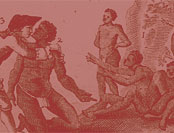


New England
> Slavery and the Slave Trade in Rhode Island
The Brown Family
and the Slave Trade:
The Voyage of the Sally
Rhode Island played a leading role in the transatlantic slave trade. Not only did Rhode Islanders have slaves—they had more per capita than any other New England state—but they also entered with gusto into the trade. By the close of the eighteenth century, Rhode Islanders had mounted at least a thousand voyages from Africa to the Americas.
Slavery in North America, however, never achieved the scale that it did in the Caribbean or South America. Of the approximately twelve million Africans transported to America by the mid-nineteenth century, six hundred thousand (or 5 %) came to mainland North America, and about one hundred thousand (or 1%) were carried in Rhode Island ships.
In 1652, Rhode Island passed a law abolishing African slavery, similar to those governing indentured European servants, where “black mankinde” could not be indentured more than ten years. The law was evidently never enforced and the demand for cheap labor prevailed. The market for sugar [4] and its related product, rum, was too compelling. During the colonial period, Rhode Island was one corner of what has been named the “triangular trade,” by which slave-produced sugar and molasses from the Caribbean were carried to Rhode Island and made into rum. The rum was then carried to West Africa and exchanged for slaves [5], to produce more sugar, more rum, and more slaves.
In 1774, tensions with England mounted and the General Assembly of Rhode Island voted to conduct a census [6]. This census, meant in part to help in raising troops, is very useful in gaining an idea of the numbers, races, and gender of the population of the state at the time.
In 1783, Moses Brown and other Quakers waged a petition campaign to abolish slavery. After a contentious battle, the General Assembly of Rhode Island passed the Gradual Emancipation Act of March 1, 1784. According to this act, children born to slaves would not remain slaves and masters could manumit healthy slaves between the ages of 21 and 40 without assuming financial responsibility. [7]
![]()
![[4] Manufacturing Molasses](../Images/Thumbnails/Item4_thumb.jpg) |
[4] Manufacturing Molasses larger view
Slaves boiled the cane juice over fires to refine the sugar. After the sugar was processed in the boiling house, the raw sugar was poured into conical pots and the molasses drained into jars below. This illustration is taken from Ladies' society for promoting the early education of negro children, “Interior of a boiling house,” published by the Infant School Society Depository, London, 1833. |
![[5] Slave Markets](../Images/Thumbnails/Item5_thumb.jpg) |
[5] Slave Markets larger view
M. Chambon. Traité générale du commerce de l’Amérique. (Amsterdam, 1783). Shown here is a slave market, detailing the examination of a slave before being purchased (top), and a slave ship awaiting a small boat filled with purchased slaves off shore, while a group of Africans in the foreground laments their departure (bottom). The Englishman examining a slave licks his chin to determine from the taste of his sweat if he is ill. |
![[6] The Census of 1774](../Images/Thumbnails/Item6_thumb.jpg) ![[6] The Census of 1774 b](../Images/Thumbnails/Item6b_thumb.jpg) |
[6] The Census of 1774 larger view
At the General Assembly of the Governor and Company of the English Colony of the Rhode Island, and Providence Plantations, in New-England, in America, begun and holden at Newport . . . on the First Wednesday in May . . . [1774]. (Newport: Solomon Southwick, 1774). Two census tallies, one with extensive manuscript annotations, are shown here and record a population in 1774 of almost 60,000, with the Black population at 6% and the Native American population at about 2.5%. By comparison, the total population of Rhode Island today is estimated at 1,048,319, with 12.8% Black and about 1% Native American (with another 14% being Latino and 1% being Asian). Later in 1774 (according to these session laws), the colony began massing arms and men, the latter in the form of militia companies in the towns of Newport, East Greenwich, Warwick, Coventry, and Providence. |
![[7] Victory on Paper](../Images/Thumbnails/Item7_thumb.jpg) |
[7] Victory on Paper larger view
At the General Assembly of the Governor and Company of the State of Rhode-Island and Providence Plantations, begun and holden (by adjournment) at Providence . . . on the last Monday in February, [1784]. (Providence: Bennett Wheeler, 1784). In 1784—with the Revolutionary War over and the transatlantic trade resuming—anti-slavery activists returned to the Assembly and presented a bill to abolish slavery in the state and to end Rhode Island’s participation in the slave trade. After an extensive battle, the Assembly enacted Rhode Island’s Gradual Abolition Act. It begins: Whereas all Men are entitled to Life, Liberty, and the Pursuit of Happiness, and the holding Mankind in a state of Slavery, as private Property, which has gradually obtained by unrestrained Custom and the Permission of the Laws, is repugnant to this Principle, and subversive to the Happiness of Mankind, the great End of all Civil Government: Be it therefore enacted . . . [&c.] |